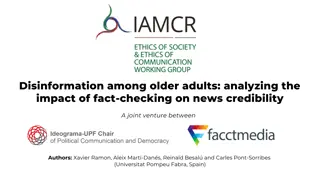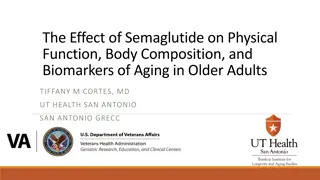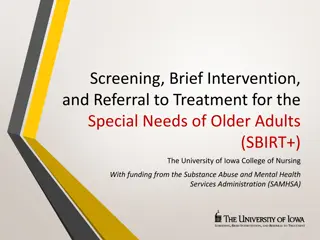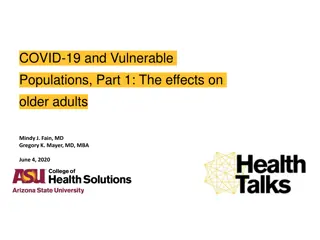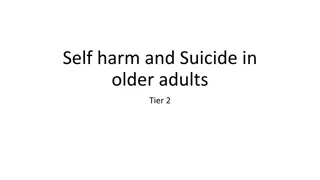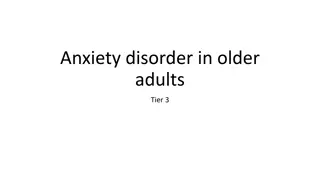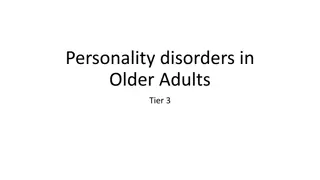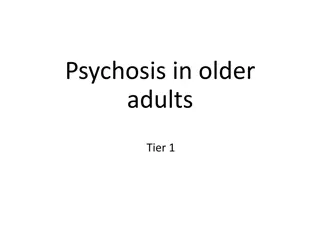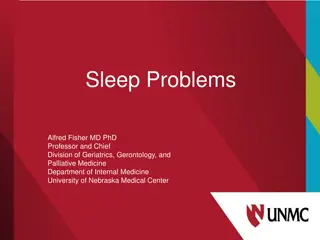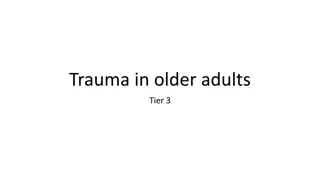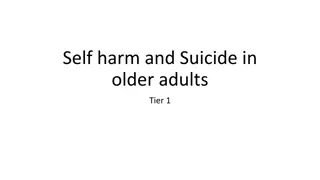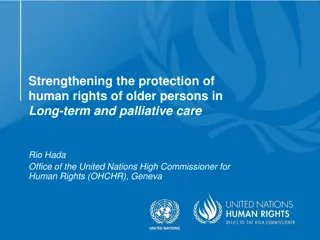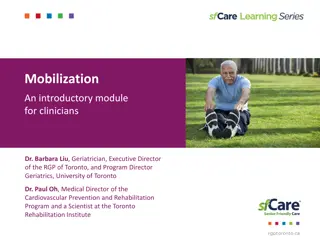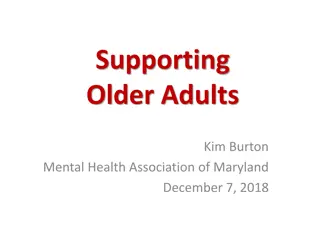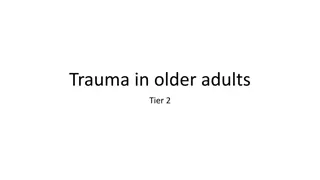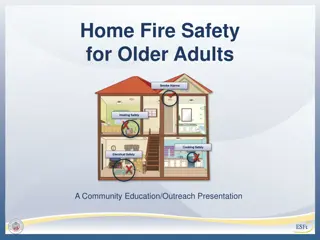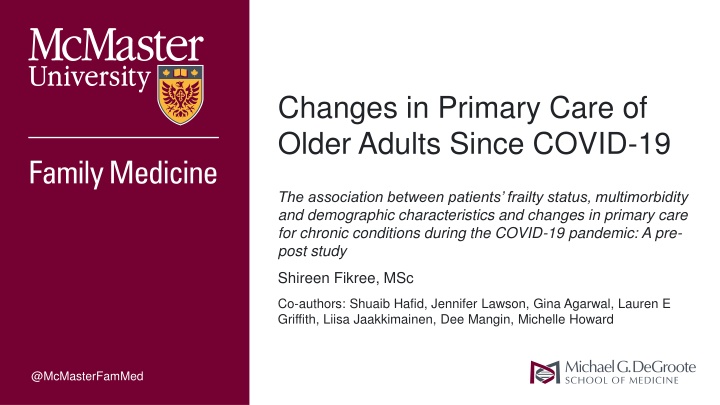
Changes in Primary Care of Older Adults Since COVID-19 Study
Explore the impact of COVID-19 on chronic condition management in older adults, emphasizing factors influencing primary care changes and the role of telemedicine. The study delves into frailty, multimorbidity, and demographic characteristics affecting primary care during the pandemic.
Download Presentation

Please find below an Image/Link to download the presentation.
The content on the website is provided AS IS for your information and personal use only. It may not be sold, licensed, or shared on other websites without obtaining consent from the author. If you encounter any issues during the download, it is possible that the publisher has removed the file from their server.
You are allowed to download the files provided on this website for personal or commercial use, subject to the condition that they are used lawfully. All files are the property of their respective owners.
The content on the website is provided AS IS for your information and personal use only. It may not be sold, licensed, or shared on other websites without obtaining consent from the author.
E N D
Presentation Transcript
Changes in Primary Care of Older Adults Since COVID-19 The association between patients frailty status, multimorbidity and demographic characteristics and changes in primary care for chronic conditions during the COVID-19 pandemic: A pre- post study Shireen Fikree, MSc Co-authors: Shuaib Hafid, Jennifer Lawson, Gina Agarwal, Lauren E Griffith, Liisa Jaakkimainen, Dee Mangin, Michelle Howard @McMasterFamMed
Presenter Disclosure Shireen Fikree Relationships w/ financial sponsors: None Any direct financial relationships, including receipt of honoraria: N/A Membership on advisory boards or speakers bureaus: N/A Patents for drugs or devices: N/A Other: N/A
Disclosure of Financial Support This program has received financial support from : N/A This program has received in-kind support from: N/A Potential for conflict(s) of interest: Other: Dr. Lauren Griffith is supported by the McLaughlin Foundation Professorship in Population and Public Health
Learning Objectives By the end of the presentation, attendees should be able to: 1. Understand the impact of COVID-19 on chronic condition management. 2. Identify key factors influencing changes in primary care management. 3. Recognize the role of telemedicine in maintaining chronic condition care for older adults.
Health Implications Associated with Ageing Multimorbidity Frailty Adverse health outcomes: Responsible for most deaths a multidimensional syndrome of reserve loss which gives rise to vulnerability and increases pt risk to adverse medical events Global prevalence among older adults:12-24% The coexistence of 2 or more chronic medical conditions Global prevalence among older adults: 55-98%
Responding through Primary Care Efforts Primary Care in Canada: the provision of longitudinal and comprehensive personalized healthcare services Family physician can screen, manage, and coordinate care for pts with multimorbidity and frailty
Join at slido.com #1888893 Start presenting to display the joining instructions on this slide.
Do you believe the COVID-19 pandemic had a significant impact on older adults' access to healthcare services? Start presenting to display the poll results on this slide.
Primary Care During the COVID-19 Pandemic March 2020 clinicians temporarily switch to providing virtual care Physician concerns over challenges providing virtual care: patients limited access + tech literacy Digital divide impacts older patients, those living with disabilities, and low SES
To understand whether the shift from in-person to virtual care during the COVID-19 pandemic impacted primary care management of older adults (65 years+) with common chronic conditions
Cont. Among those with hypertension, diabetes and/or chronic kidney disease to what extent has the frequency of routine monitoring activities (blood pressure, number of HTN/Metformin prescriptions, HbA1c & eGFR tests) changed comparing 14 months pre-pandemic to 14 months since the pandemic. Are these changes associated with patient age, sex, neighbourhood income, multimorbidity, and level of frailty?
Study Design Retrospective closed cohort using data from the MUSIC network Up to date pt. level clinical data from primary care EMR systems in Hamilton, ON Sub-set of pts 65 + years from 1 of 2 interprofessional academic family practices whose physician completed assessment for frailty in 2019
Cohort 2043 patients (65 yrs and older) identified with CFS score Observation Period (14 months pre/since pandemic): After data quality exclusions and chronic condition specification: 658 patients identified (32.2%) Pre-COVID: Feb 19, 2019 March 14, 2020 Since-COVID: March 15, 2020 May 9, 2021
Outcomes of Interest Cohort Level Chronic Disease Type Outcomes of Interest Chronic Disease Specific Cohort Any pt with DM, HTN, or CKD No. of BP measures, mean SBP/DBP HTN only, no DM No. HTN Rx DM only, not HTN Any pt. with DM No. Metformin Rx Any pt. with DM Any HbA1c test done Mean HbA1c score Any pt. with DM, HTN, or CKD Any eGFR test done Mean eGFR measures
Outcomes of Interest Stratify outcomes by patient characteristics (age, sex, neighborhood-level income quintile, frailty level, and condition count category) Binary Logistic Regression: Investigating associations between patient characteristics and reductions in frequencies of medication prescriptions, BP measures, and lab tests Dichotomized outcomes: Were there reductions during the pandemic compared to the pre-pandemic period (yes) or the same or more (no).
Descriptive Analysis 658 primary care patients with hypertension, diabetes, and/or chronic kidney disease Mean age: 75 years Approximately half (52.9%) had a frailty score of 1-3 (low) Mean 4.4 chronic conditions, most common: hypertension (70.7%)
Chronic disease management activities in patients Pre- pandemic pandemic Processes Blood pressure measures (mean) 1.7 0.6 Any HbA1c test in those with DM (%) Any eGFR test (%) 85.9% 68.7% Hypertension medication Rx s Hypertension without DM (mean) DM without hypertension (mean) Metformin Rx s (mean) 1.2 1.0 Test results Blood pressure mmHg (mean) Systolic Diastolic 74.6 73.2 HbA1c % in DM only (mean) 7.2 7.1 eGFR (mL/min/1.73 m2) (mean) 64.9 62.4 During the Mean or percent change 95% Confidence Interval P value -1.14 -22.8% -1.28, -1.00 -0.29, -0.17 <0.001 <0.001 88.0% 65.3% -17.2% -0.21, -0.13 <0.001 2.6 2.1 -0.48 -0.75, -0.20 <0.001 2.1 1.7 -0.41 -0.76, -0.06 0.023 -0.13 -0.30, 0.04 0.137 135.2 133.8 -1.42 -1.37 -0.12 -2.4 -3.20, 0.36 -2.54, -0.20 -0.24, 0.01 -3.12, -1.72 0.117 0.022 0.071 <0.001
Changes in Outcomes Stratified by Patient Characteristics The same findings extended when stratifying changes in outcomes to all levels of patient characteristics However, those who were older, had increasing levels of frailty, and increasing numbers of chronic conditions generally experienced lesser reductions in care
Changes in Outcomes Stratified by Patient Characteristics
Association b/w Individual Pt Characteristics and Changes in Outcomes Odds of having fewer: Model Significant? Results: BP measures No Not presented HTN Rx s Metformin Rx s HbA1c tests eGFR tests Yes Female pts were less likely to have had a reduction compared to male pts Patients with 2 chronic cond s & those with 4or more were 2x as likely to have had a reduction compared to those with only 1 cond
Before this presentation, did you have any preconceived notions about the effectiveness of telemedicine in managing chronic conditions?" Start presenting to display the poll results on this slide.
Interpretations Those who are most at risk of contracting COVID-19 can take advantage of virtual- visits digital divide may not be an issue Slight mean dec in number rx stable use of these meds are important for chronic conditions (DM and HTN) Minimal changes to disease monitoring parameters important to maintain longitudinal relationships with older patients with chronic conditions.
Overall Messages Overall decrease in routine preventative & monitoring services, but no substantial change to disease monitoring parameters Generally, older age, increasing level of frailty, and increasing numbers of chronic conditions were associated with lesser reductions in care. Patients living in lower income neighbourhoods did not experience notable changes.
Thank you! Please evaluate the session

